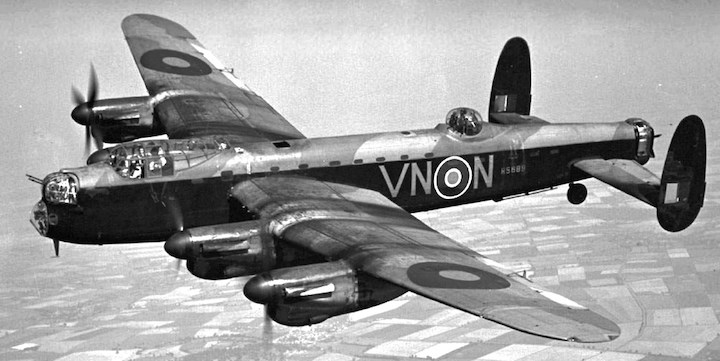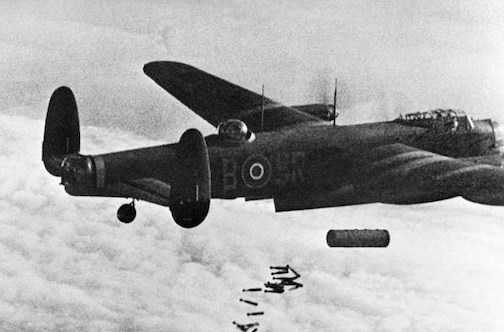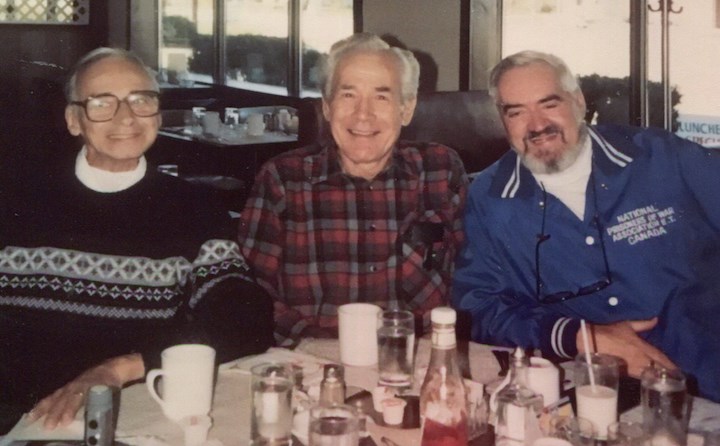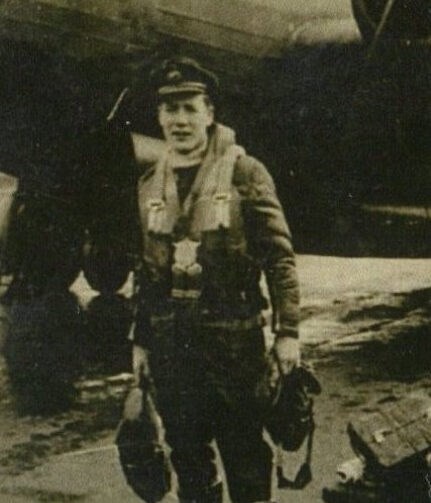 By Tom St. Amand and Tom Slater
By Tom St. Amand and Tom Slater
Sarnian Gene Atyeo was an excellent aviator, the type of pilot that airmen wanted behind the controls in any situation – and especially over enemy territory.
Eighteen-year-old Clem Pearce, a crew mate aboard Lancaster PB258, called him “brilliant.” Atyeo himself was only 22-years-old, but he was the third oldest member of the crew. Only Sarnia-born Blake 'Pat' Patterson, 32, and John Andrews, 30, were older.
On Saturday evening, August 12, 1944, the crew of Lancaster PB258 felt prepared but nervous about tonight's operation. At 2134 hours, Atyeo guided the bomber down the runway at the RAF base just south of the village of Ludford Magna in Lincolnshire. Atyeo had been overseas for just over a year and this was his 13th operation. With luck, the Lancaster crew would return safely in the early hours of August 13.
RAF Ludford Magna was approximately 240 kilometres north of London and nearly 1000 kilometres from tonight's target of Brunswick (Braunschweig), Germany. Lancaster PB258 carried one 2,000 lb bomb and a dozen 500 lb bombs, in addition to a crew of eight. Most Lancaster crews comprised seven men but, as part of the elite RAF 101 Squadron, Atyeo's eighth crew member was Special Operator Henry Blake, 20, a German Jew who had been living in Britain when the war began. Blake's real name was Hans Heinz Schwarz. Born in Berlin, he and his family had fled from the Nazi regime in 1939. His fluency in German qualified him to operate the bomber's top secret equipment known as Airborne cigar or ABC.
ABC had been installed in the Lancasters of RAF 101 Squadron since October 1943, and its effective use on bombing missions in the past 10 months had been worth the effort in developing it. If all went well, as the bombers approached their targets, Blake would be responsible for listening to hundreds of German broadcasts over VHF bands. If he heard that ground control was providing specific information about the location of Allied bombers to German night fighters within range, he would use ABC to jam as many as three signals simultaneously. What the fighters could not see, they could not hit. Blake's working knowledge of German was excellent and, like other ABC operators in previous operations, he had listened to frustrated Germans refer to them as “those English bastards.”

Although the jamming equipment worked well and saved many lives, the missions were especially risky for crews with this special squadron. Since the range of ABC cover was limited to 80 kilometres, the Lancasters not only had to spread themselves out among the stream of Allied bombers, but also had to fly on every raid. The high casualty rate for the 101 Squadron was inevitable. In a four-month stretch between November 1943 and March 1944, the unit lost 17 aircraft.
Tonight, they were one of nine Lancasters providing ABC cover to the 379 aircraft intent on bombing Brunswick. That they were targeting Brunswick, a city of 200,000 residents in Lower Saxony, was not surprising. Beginning in 1940, Allied aircraft attacked it 42 times during the war. As part of Combined Bomber Offensive, Brunswick had been a regular target for RAF raids at night and American bombers during the day.
Brunswick itself, though well protected by night fighters and batteries of anti-aircraft guns, provided Bomber Command with several tempting targets: machine and munitions works; the harbour and a chemical plant; and canneries and railway stations. This operation was even riskier because for the first time aircraft were using H2S, a ground radar that Bomber Command hoped would provide bombers with pinpoint targeting. That meant that the usual Pathfinder Force marking the targets before the bombers arrived was purposely held back.
As Lancaster PB258 flew southeast over the North Sea and over the Netherlands, Atyeo and his crew were vigilant. In the rear of the plane sat 19-year-old David Balchin, the tail gunner. Balchin and Pearce, the mid-upper gunner, sat in their respective turrets and constantly scanned the night sky for enemy aircraft. By necessity, each airman was outfitted with electrically heated under garments beneath their flight gear. Their inner layer of clothing was plugged into the aircraft's electrical current for their protection. On each operation, they were exposed to the extreme cold and without the electricity warming their bodies, they risked incurring frostbite or freezing to death. Especially Balchin. At 20,000 feet in the open rear turret, Balchin faced temperatures of -45 Celsius.
Rounding out Atyeo's crew were John Andrews, the wireless operator; Blake Patterson, the bomb aimer; a pair of 20-year-olds—Navigator John Lovatt and Flight Engineer Trevor Keeling—and Henry Blake. Henry had joined the RAF on Christmas Eve 1942, shortly after his 18th birthday. A family member mentioned that after Henry had enlisted, he confided that he was “prepared to give his life for his country which had given them so much.” More than 50 years after the mission, Clem Pearce referred to the 19-year-old Blake as “the bravest man I ever knew.”

The men had flown together for the past month and, with the exception of Blake, knew one another well. They were a cohesive group and Atyeo set the tone for the crew. When he had left the family home on Nelson Street to enlist with the RCAF in June 1942, Gene’s goal was to be a pilot because he had a “keen desire to fly.” Training instructors were impressed, assessing him as a “better than average student” and a “very fine type of young man, a willing worker.” Most importantly, Flying Officer Atyeo inspired much confidence in his men.
As they approached Brunswick amidst powerful searchlights and exploding anti-aircraft fire, Atyeo and his crew focussed on the three targets assigned to them. They unloaded their payload successfully, after which Atyeo headed north, descended, and levelled the Lancaster at 16,000 feet. It was now 0110 hours on Sunday morning. They were approximately 30 kilometres north of Hanover and were starting to head west to England when trouble caught up to them.
Balchin's voice from the rear turret warned that flak was coming closer behind them. Atyeo didn't panic, but asked that he be advised if the flak got any closer. Before Balchin could answer, flak punctured the main fuel tanks on both sides of the bomber, and the starboard tank burst immediately into flames. Gene wasted no time and ordered the others to “Bail out!”
The fire kept growing, but Gene kept the plane flying so that his crew could get out safely. In the next few moments, he repeatedly asked if anyone was left and, once he heard no responses, Atyeo parachuted into the dark abyss. Upon landing, he incurred his only war injury when a barbed wire fence snagged his leg. Gene carried the scar for the rest of his life, but he got off easy.
He managed to elude the Germans for three or four days by hiding during the day and moving cautiously at night. Years later, he told his family that “sometimes in the morning you'd see what you had drunk the night before and you knew it wasn't good.” He found decent hiding places and one night hid in some bushes bordering a field and fell asleep. The noise of German ladies working in the field awakened him in the morning and he watched with trepidation when one lady started walking straight toward him.
Another few steps and she'd see him. Fortunately, she stopped just a few feet short of him, more intent on finding a spot to relieve herself than on inspecting nearby bushes. She did her business before returning to the field to resume working. The Germans eventually captured Gene and he joined his other crew members who'd been captured and detained in the same building.
Eventually, Gene and his crew heard the disturbing aftermath of their operation.
Only six airmen aboard Lancaster PB258 survived.
The Germans found the corpses of John Andrews and Henry Blake, along with their charred Lancaster that had landed in a farmer's field 80 kilometres northwest of Hanover. The Germans originally buried the two airmen in a joint grave in a cemetery 15 kilometres south of Barber, a nearby village; however, after the war, the remains of both men were disinterred and reburied in Belgium. In their post-war statements, four crew members confirmed that flak from an anti-aircraft gun had struck their Lancaster near Hanover. The crew also learned the grim results of their final bombing operation: no effective concentration of bombs found their mark in Brunswick and H2S, the new radar system, was a disappointment; in fact, nearby towns were bombed by mistake. Worse yet, the enemy shot down 27 aircraft or 7% of the Allies bombers on the raid.
Gene was sent to Stalag Luft III, a Luftwaffe-run POW camp near the town of Sagan, Poland. The camp held captured Western Allied air force personnel, and Gene was there for over five months until the night of January 27, 1945. With Russian forces closing to within 20 kilometres of the camp, Hitler ordered the immediate evacuation of the camp. The weather was frigid, the conditions horrible as men in six compounds started what became known as ‘The Long March’ or ‘The March.’
Gene was one of 257,000 POWs who were forcibly marched westward across Poland, Czechoslovakia, and Germany in brutal weather with limited food, water, and clothing. By February 6, exhausted survivors from Stalag III straggled into another camp, known as Stalag III-A at Luckenwalde, approximately 52 kilometres south of Berlin. When the war ended, Gene was weaker and thinner, but he had survived his ordeal.

Unless he was asked, Atyeo rarely spoke about the war for the rest of his life. He had been a coremaker at Holmes Foundry before he enlisted and he returned to the foundry once he had settled in Sarnia. Gene had never been afraid of hard work, so it was no surprise that he eventually became a manager at the plant. After the war, he was still a young man in his mid-20s, and his family life soon changed dramatically. Gene got married and over the next two decades, his wife and he became parents to seven children.
When he was growing up in Sarnia, he had also spent time on his uncle’s fruit farm in Vineland in the Niagara area. He never lost his love of the land and his moves to four acres of land on Murphy Road and later to a lot outside Petrolia with two orchards and a pond brought him satisfaction. His family acknowledged Gene “seemed the happiest when he was out in the field, tending to the crops and the fruit trees on his property.”
Gene was delighted when former crew mates David Balchin and Clem Pearce visited him in Sarnia in 1997, more than half a century after their fateful operation to Brunswick. A decade later, the man who piloted Lancaster PB258 for the final time passed away on September 15, 2007 at the age of 85.
St. Amand and Slater are the authors of Valour Remembered: Sarnia-Lambton War Stories, available at The Book Keeper.
For more Sarnia Remembers stories, click here.